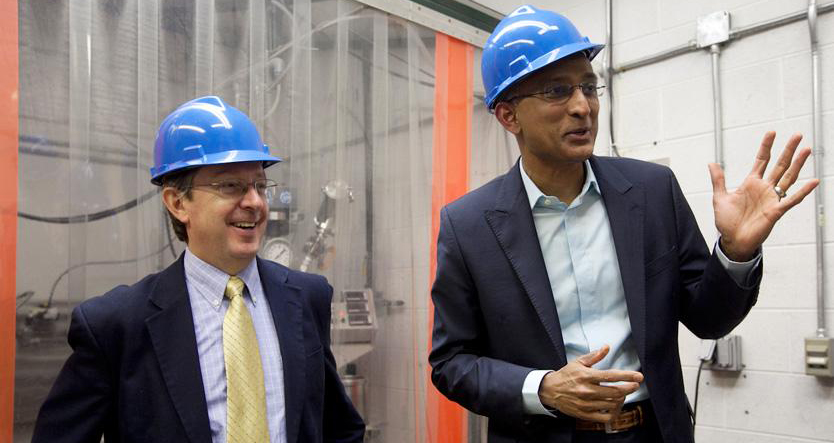
Developing technologies to produce biofuels is a little like bargain hunting: the goal is to come up with a valuable product for a competitive price. To prepare these technologies for commercial use, researchers at the Great Lakes Bioenergy Research Center (GLBRC) are challenged with figuring out how to generate large quantities of biofuel both efficiently and affordably.
Fortunately, GLBRC researchers at Michigan State University's Biomass Conversion Research Laboratory (BCRL) have found a way to turn corn stover, a common cellulosic feedstock, into ethanol much more quickly without sacrificing quantity or quality.
The lab's new technique, described in a recent issue of Energy and Environmental Science, brings the total processing time down from nearly two weeks to just two days, and potentially increases ethanol yields.
"The BCRL process is simple and industrially relevant, with a lot of potential to help commercialize cellulosic biofuel production," says Mingjie Jin, an MSU chemical engineering doctoral student and GLBRC researcher. Jin is developing the process with Bruce Dale, who leads the BCRL and the center’s deconstruction research team.
Cellulose polymers, composed of long, densely packed chains of sugar subunits, give plant cell walls their structure. Scientists must spend time and energy deconstructing these complex sugars before they can be converted into ethanol.
Until now, common approaches to this problem have included mixing enzyme cocktails to break down pretreated plant biomass, and identifying useful microbial fermenters like yeast. The BCRL process is unique because it focuses on improving the design and arrangement of the breakdown and fermentation processes as a whole, rather than on the individual steps.
"Process design, or process engineering, analyzes and evaluates the whole picture of cellulosic biofuel production,” says Jin.
"The results of process engineering can be used for strategic decision-making and for defining the scientific questions we want to answer."
The BCRL approach involves removing those portions of cellulosic biomass—in this case, corn stover that has been pretreated by the lab’s own ammonia fiber expansion (AFEX TM) technology—that are still not converted to sugars by enzymes after 24 hours, and adding them to later cycles of the biofuel production process.
This means that, rather than waiting for days until the most stubborn plant material has broken down, the resistant residue from each step is combined and converted without holding back the rest of the biomass and delaying the process.
Because some of the enzyme and all of the yeast cells used in the process are recycled, the new method also has the potential to make biofuel production less expensive.
"Based on our current results, the BCRL process could reduce the cellulosic ethanol production cost by around 16 percent, and there is still much room for improvement," says Jin.
With the promise of this new technology, the next task for GLBRC scientists is to weigh the tradeoffs of different process designs. Typically, biomass breakdown and fermentation steps take place in separate reactors, but they can also be combined into a single reactor in a process called simultaneous saccharification and co-fermentation, or SSCF.
Combining the lab’s new process with SSCF proved to be the most efficient, but it also used up more enzyme than the separate reactor approach, making it more expensive.
Enzymes work best in temperatures that are too hot for yeast to withstand, so using a single reactor means that the conditions are just right for the yeast, but the enzymes aren’t performing at the top of their game.
GLBRC researchers are already tackling the temperature problem and seeking out a solution that will provide the best of both worlds in terms of efficiency and economy. Trey Sato, a GLBRC researcher at the University of Wisconsin-Madison, is searching for fermentation microbes that don’t mind doing their work in the same scalding conditions that the enzymes prefer.
The emphasis on process design demonstrated by Jin’s work reflects the BCRL’s focus on engineering and optimization in order to develop biofuel technologies for large-scale, industrial applications. The BCRL works on some projects with MBI, a Michigan company that specializes in scaling up and “de-risking” bio-based technologies.
"With our strong support from the GLBRC, and by working together with our partners at MBI, we have been able to make significant advances in cellulosic biofuel technology,” Dale says.
Bobby Bringi, CEO of MBI, notes that cellulosic biofuels present some unique challenges when it comes to commercialization.
"Traditional fermentation technologies are very well developed today, but with cellulosic biofuels, you have to bring biomass into the equation,” he says.
Developing cellulosic biofuel technologies that are effective, efficient and competitive with other energy options may be a tall order, but joining basic research with insights from industry could help accelerate these efforts.
"Preparing biomass sugars for large scale fermentation is a challenging area,” says Bringi, “and process design research is important to address these new challenges."